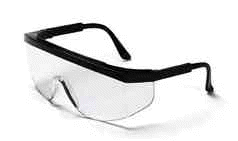  Impact goggles or safety glasses are necessary as the minimum
protection when a potential exists for flying particulate matter to impact your
eyes. This occurs in most all machining, wood-cutting (or lathe work), as well as in
much chemical work, grainary operations, welding/brazing/torch-cutting. The
requirement for impact protection by goggles/glasses may be obviated by the use of
eye/face protection which includes impact protection by means of a more
protective item, such as an impact face-shield, helmet, or impact-resistant full-face
respirator. Impact goggles or safety glasses are necessary as the minimum
protection when a potential exists for flying particulate matter to impact your
eyes. This occurs in most all machining, wood-cutting (or lathe work), as well as in
much chemical work, grainary operations, welding/brazing/torch-cutting. The
requirement for impact protection by goggles/glasses may be obviated by the use of
eye/face protection which includes impact protection by means of a more
protective item, such as an impact face-shield, helmet, or impact-resistant full-face
respirator.
 Impact goggles or glasses (with side shields if stipulated by the hazard
assessment pertaining to the work) which conform to ANSI Z87.1
specifications. (They will be stamped with Z87.1 if they conform, but the presence
of that marking does not make them impact
protection. ANSI Z87.1 contains specifications for many different
types of protective eyewear, including splash goggles, impact protection, and face
shields.) Side shields are necessary with impact
glasses if there is a chance of impact coming from the side. Impact goggles or glasses (with side shields if stipulated by the hazard
assessment pertaining to the work) which conform to ANSI Z87.1
specifications. (They will be stamped with Z87.1 if they conform, but the presence
of that marking does not make them impact
protection. ANSI Z87.1 contains specifications for many different
types of protective eyewear, including splash goggles, impact protection, and face
shields.) Side shields are necessary with impact
glasses if there is a chance of impact coming from the side.
 The
proper donning and doffing (putting on and taking off) of eye protection is largely
intuitive for most people, but the following points are emphasized for those wearing prescriptive glasses. The
proper donning and doffing (putting on and taking off) of eye protection is largely
intuitive for most people, but the following points are emphasized for those wearing prescriptive glasses.
1) Impact goggles are the best alternative for wearing over eyeglasses. They need to be inspected for comfort, visibility, fit (strength of elastic band).
Do not use goggles if they do not fit comfortably, or impair your vision. Antifog droplets and wipes can be used to reduce condensation.
2) Over-the-glasses safety eyewear with side shields (by U-Line) are an acceptable alternative in many research labs. These are available to the Purdue Chemistry community at no cost through the Dept. Safety Committee, and can be picked up at the Chem Shop in WTHR 141.
Goggles or glasses have been properly put on when they are situated comfortably on
the face in such a manner that they cover both eyes, will not slip down, and allow you to
see your work. Side shields are necessary with impact glasses if there is a chance
of impact coming from the side. Removing the goggles or glasses requires no special
precautions unless they have been contaminated in some manner with a harmful substance.
In the case of exposure to chemical hazards that coats the PPE eyewear, it may be advisable to remove it AFTER getting one's face into the eyewash or emergency shower.
Always know where the eyewash and shower are located, and how to get there with
your eyes closed! (And keep the path from your work to that location completely
clear of trip/slip hazards.)
 Protective eyewear is limited mostly by whether you remember to keep it on your eyes.
Impact goggles and glasses will not protect adequately against violent explosions
of apparatus or chemical reaction set-ups; if this is a possibility there should be a
blast shield between you and the apparatus or set-up. Protective eyewear, especially
plastic, can become scratched and scuffed to the point where it interferes with vision --
dispose of equipment when this is the case.
Protective eyewear is limited mostly by whether you remember to keep it on your eyes.
Impact goggles and glasses will not protect adequately against violent explosions
of apparatus or chemical reaction set-ups; if this is a possibility there should be a
blast shield between you and the apparatus or set-up. Protective eyewear, especially
plastic, can become scratched and scuffed to the point where it interferes with vision --
dispose of equipment when this is the case.
 Goggles
and glasses should be kept clean with mild soap and water, and stored in a dry, temperate
atmosphere out of harm's way. Avoid hanging eyewear by the elastic band, as this can
significantly weaken the band by prolong stretching in a short time. If protective eyewear items are not
contaminated with chemical, biological, or radioactive material, there are no special
disposal considerations; they are regular trash. Goggles
and glasses should be kept clean with mild soap and water, and stored in a dry, temperate
atmosphere out of harm's way. Avoid hanging eyewear by the elastic band, as this can
significantly weaken the band by prolong stretching in a short time. If protective eyewear items are not
contaminated with chemical, biological, or radioactive material, there are no special
disposal considerations; they are regular trash. |

